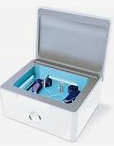Importance of Hearing Aid Dryers

March 21 2025
I am a member of the Saddlebrooke Hearing Discussion Group. In this month’s article I would like to discuss the importance of using a hearing aid dryer to help maintain your hearing aids. One often overlooked but crucial aspect of hearing aid maintenance is moisture control.
Considering our dryer climate in Arizona you may not feel that it is important to worry about moisture harming your hearing devices. However, moisture is the nemesis of hearing aids. Whether it’s from humidity, perspiration, or unexpected exposure to water, the delicate components of your hearing aids are susceptible to damage when moisture infiltrates their inner workings. The consequences of moisture damage range from reduced performance to complete device failure.
Hearing aid dryers are purpose-built devices designed to remove moisture from your hearing aids effectively. These devices typically use a combination of heat, desiccants, and airflow to absorb and evaporate any moisture present. Investing in a hearing aid dryer not only helps prevent potential damage but also contributes to overall device hygiene.
At a recent meeting of our discussion group, we discussed hearing aid dryers. It was interesting that many members had never heard of these devices. Nor had they been mentioned by their audiologist. That was surprising to me, which is the reason I decided to write this article. So be sure to ask your audiologist about the benefits of a dryer.
I personally have had both my hearing aids and cochlear implant damaged by moisture. Fortunately, I was able to have the devices replaced under warranty. I don’t wear my cochlear implant and a companion hearing aid when I am at the fitness center. I instead wear my older hearing aid which I have found to be more water resistant since it is a rechargeable hearing aid. I further protect it with an Ear Gear sleeve, which is a spandex sleeve that fits over the device. They make sleeves for various sizes of behind the ear devices as well as cochlear implants. Their website is https://www.gearforears.com. The first thing I do when I get home from the fitness center is place my hearing aid in a dryer.
There are several types of hearing aid dryers available in the market, each designed to cater to different needs and preferences. Here are some common types:
Electronic Hearing Aid Dryers: These dryers use electronic components, such as a fan and heating element, to circulate warm air and remove moisture from the hearing aids.
Desiccant-Based Hearing Aid Dryers: These dryers use desiccant materials (silica gel or similar substances) to absorb moisture from the hearing aids and may work without a power outlet. These dryers are handy when there is no power supply around, especially when travelling.
UV-C Light Hearing Aid Dryers: Some dryers use UV-C light to kill bacteria and fungi while also providing a drying function. They can be effective in promoting both dryness and hygiene.
Some dryers are a combination of the three types listed above. Talk to your audiologist to get their recommendation or attend one of our meetings to get a suggestion from one of our members.
Our group meets on the 2nd Friday of every month at 10 AM in the Catalina Room in the Mesquite Building. For more information about the meetings contact Jennifer Jefferis, jenjefferis4u@gmail.com, or Lyle Larson, lllarson72@gmail.com. If you have questions about this article or would like to suggest a future article topic, my contact email is tgaule@outlook.com